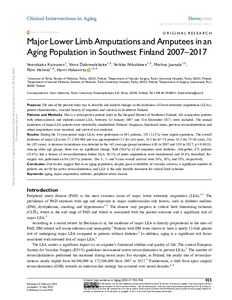Major Lower Limb Amputations and Amputees in an Aging Population in Southwest Finland 2007-2017
Koivunen Veerakaisa; Dabravolskaite Vaiva; Nikulainen Veikko; Juonala Markus; Helmiö Päivi; Hakovirta Harri
https://urn.fi/URN:NBN:fi-fe2022091258437
Tiivistelmä
Purpose: The aim of the present study was to describe and analyze changes in the incidences of lower extremity amputations (LEAs), patient characteristics, vascular history of amputees and survival in Southwest Finland.
Patients and Methods: This is a retrospective patient study in the Hospital District of Southwest Finland. All consecutive patients with atherosclerosis and diabetes-caused LEA, between 1st January 2007 and 31st December 2017, were included. The annual incidences of major LEA patients were statistically standardized. Patients' diagnoses, functional status, previous revascularizations and minor amputations were recorded, and survival was analyzed.
Results: During the 11-year-period major LEAs were performed on 891 patients, 118 (13.2%) were urgent operations. The overall incidence of major LEA was 17.2/100 000 and was age-dependent (3.1 for <= 64 years, 34.3 for 65-74 years, 81.5 for 75-84 years, 216 for >= 85 years). A decrease in incidence was detected in the <65 year-age-group (incidence 4.98 in 2007 and 1.88 in 2017; p = 0.0018). Among older age groups, there was no significant change. Half (50.6%) of all amputees were diabetics. Altogether, 472 patients (53.0%) had a history of revascularization before LEA. 80.1% of index amputations were transfemoral and 19.9% transtibial. Re surgery was performed on 94 (10.5%) patients. The 1-, 3-and 5-year overall survival were 56%, 30%, and 18%, respectively.
Conclusion: Our results suggest that in an aging population, despite good availability of vascular services, a significant number of patients are not fit for active revascularization, and LEA is the only feasible treatment for critical limb ischemia.
Kokoelmat
- Rinnakkaistallenteet [27094]
